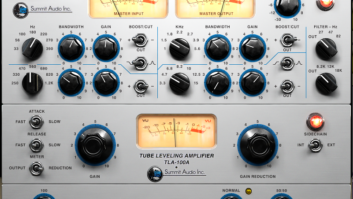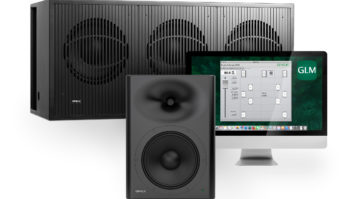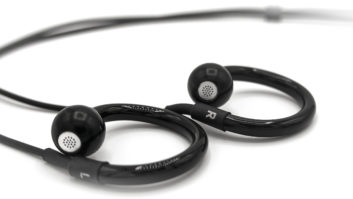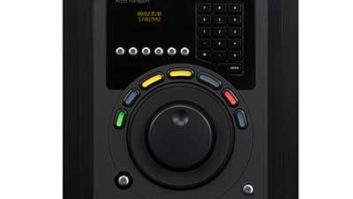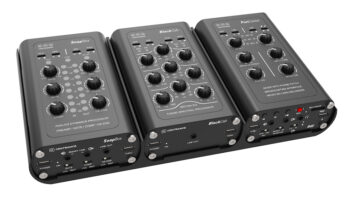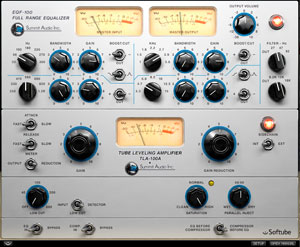
Over the past few years, the Swedish software company Softube has built a sterling reputation for creating DAW plug-ins that model tube gear with punctilious precision. Their newest product, Grand Channel, emulates the Summit Audio TLA-100A Tube Leveling Amplifier and EQF-100 Full Range Equalizer (a passive equalizer with tube output stage). The two processors can be used in composite configuration (the Grand Channel) or as discrete plug-ins.
The cross-platform bundle is available in VST, VST3, AU, RTAS and AAX formats and for 32- and 64-bit hosts. An iLok is required. I tested Version 1.3.10 of the AU plug-in in Digital Performer 7.21 on an 8-core Mac Pro running OS X 10.6.8.
Channel Surfing
The EQF-100 component provides four overlapping parametric bands—low, low-midrange, high-midrange and high—with seven fixed frequencies each. Each of the bands can be switched to either boost or cut and can be independently bypassed. The bandwidth controls are a bit counter-intuitive, in that their “0” setting produces a narrow bandwidth while “10” is wide—the opposite of what a Q control would effect. All four bands provide peaking filters, and the high and low bands can be alternatively switched to provide shelving boost or cut. Adjustable low- and high-cut filters are also included, along with VU-style input and output meters.
The EQF-100 generates harmonics—principally sweet second-harmonic distortion—when its output level exceeds roughly -3 dBFS. When the output meter shows level exceeding 0 dB (equal to -9 dB RMS), the plug-in begins to saturate, producing modeled tube compression.
The TLA-100A component features soft-knee compression akin to that found in opto-electronic units but is capable of faster attack and release times than those types of compressors typically afford. The TLA’s attack and (program-sensitive) release times can each be switched to a preset fast, medium or slow setting. You raise the gain reduction control to lower the threshold and increase the compression ratio at once. The TLA-100A’s VU meter can be switched to show either the amount of gain reduction or output level.
Raising the TLA-100A’s saturation control decreases the modeled compressor’s headroom, promoting distortion that’s edgier in character than that produced by the EQF-100. Its main application is taming transients on drums and other percussive tracks. An associated LED lights when distortion is being generated. When the TLA-100A is instantiated in stereo, its two channels are arbitrarily stereo-linked. While this helps preserve the level balance for the stereo image, in my experience it can also collapse the image slightly. For that reason, I wished the channels could be unlinked.
The EQF-100 and TLA-100A each have an output-gain control; the compressor’s follows its saturation control, while the equalizer’s follows the EQ controls and drives modeled output tubes (thereby acting simultaneously as both an output and de facto saturation control). The two processors can be independently bypassed and their order in the audio path reversed. No matter the order, the EQF-100’s input and output meters always show I/O levels at the respective beginning and end of the Grand Channel’s entire signal chain (not necessarily those for the equalizer).
Kicking the Tires
Grand Channel dramatically improved the sound of a weak kick drum track. Setting the TLA-100A (pre-EQ) to provide around 5 dB of compression—using fast attack and release times—mowed down the kick’s attack, creating a sound that heavily highlighted the drum shell’s sustain. Raising the parallel inject control halfway (producing a 50 /50 mix of compressed and uncompressed signal) rekindled the original attack and married it to the enhanced shell sustain. I then boosted generously with the EQF-100 below 56 Hz (shelving) and at 3.9 kHz (peaking) to enhance both aspects of the kick, giving the track more heft and attack. The finishing touch was cutting slightly at 560 Hz to attenuate a residual stiff, cardboard-y aspect of the sound. The combined sonic result of these tweaks was a remarkable improvement.
The same project’s snare drum track required lavish EQ boost at 220 Hz and 5.6 kHz to give it more punch. Even boosting these frequencies close or fully to the max, the sound was very smooth. That said, I wished the EQ boost was a tad more responsive; even with 220 Hz fully cranked with the broadest possible bandwidth, I didn’t feel like I got as much upper-bass boost as I needed for this particular track. I was also disappointed that the gain knobs for each band were not marked in decibels. A readout along the GUI’s bottom strip displayed precise decimal values for each control I moused over, but those for the bands’ gain controls were based on an arbitrary scale.
The EQF-100 sounded incredible on electric bass. After boosting the bottom end and rolling off the highs, I cranked the output volume until the output meter read -1 to +1 VU on peaks. That added wonderful distortion that would give any high-end, tube-based hardware unit a run for its money. The bass was burping like a dyspeptic fast-food junkie (cool!), but the output was occasionally clipping. Patching the TLA-100A downstream, I set a slow attack and fast release and shaved 2.4 dB off the output gain. That made the bass pulse and simultaneously prevented clipping. Switching the compressor’s low-cut control into the audio path was the final touch—its continuously variable nature allowed me to more precisely dial in a rumble filter (at 39 Hz) than if I’d used the EQF-100’s stepped controls for that purpose.
Niche Performer
The TLA-100A sounded very transparent on vocals and other tracks in need of natural and smooth-sounding opto-type compression. That said, it wasn’t an effective de-esser. The attack time was too slow to catch the leading edge of fricatives. And because the gain reduction control adjusts the two parameters inversely, I also couldn’t get enough compression depth without lowering the threshold too much and throwing the baby out with the bathwater. I also found it odd that the sidechain could only accept stereo input for a mono instantiation of the plug-in.
The compressor didn’t impress me on drum room mics. Even set to “fast,” the attack and release times weren’t zippy enough to create the explosive, hyperventilating sound I was after.
Grand Channel also lacks A and B workspaces and Undo/Redo facilities. Also, the GUI’s graphics are a little too realistic for their own good: Certain gain-reduction settings become impossible to see because virtual glare on the knob blots the control’s white hash mark.
The TLA-100A is a smooth-sounding compressor but limited in the breadth of applications. The pearl in this oyster is the EQF-100A. Whether you’re after pristine equalization or lush, hyper-creamy tones, the EQF-100A delivers the goods in spades. It’s worth the $329 admission ticket alone.
TRY THIS
Mult your lead vocal track. Instantiate the TLA-100A on the original lead vocal track. On the mult, boost 3.3 kHz heavily in the EQF-100, using a bell-curve filter and wide bandwidth. Remove the mult from the mix bus, and bus it to the TLA-100A’s external sidechain. The TLA-100A will compress more heavily when the singer hits the top of her range, automatically putting a safety lid on choruses.
